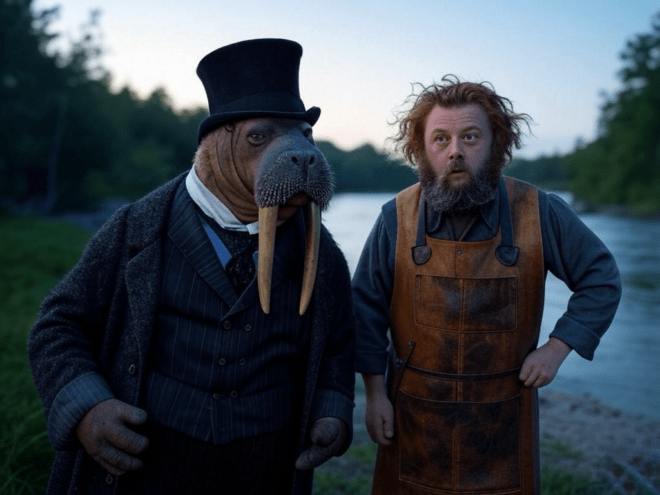

Lewis Carroll’s poem “The Walrus and the Carpenter”, from “Through the Looking-Glass” (1871), is a whimsical yet haunting narrative that lends itself to profound allegorical interpretation. On the surface, it tells the story of a Walrus and a Carpenter who lure a group of eager oysters for a “pleasant walk” only to devour them in the end. Beneath its playful veneer, the poem serves as a potent metaphor for the mechanics of populism, a political strategy that often cloaks self-serving intentions in the guise of communal goodwill, only to exploit and ultimately betray its followers. This paper explores how “The Walrus and the Carpenter” mirrors the seductive rhetoric, manipulative tactics, and destructive outcomes of populist movements, drawing parallels between the oysters’ fate and the disillusionment of populist supporters who are misled by promises of empowerment and prosperity. Through theoretical insights from Ernesto Laclau and literary comparisons to George Orwell’s “Animal Farm”, the analysis reveals the universal patterns of populism’s deception.
I. Introduction: The Allure of Populism and the Poem’s Framework
Populism thrives on the discontent of the marginalised, promising to elevate the “common people” against a perceived elite or establishment. Its rhetoric is emotionally charged, simplistic, and polarising, painting a vision of unity and salvation that resonates with those who feel ignored or disenfranchised. Yet, history and contemporary examples reveal a recurring pattern: populist leaders or movements frequently betray their followers, consolidating power or wealth for themselves while leaving their supporters disillusioned or worse off. This dynamic is vividly encapsulated in “The Walrus and the Carpenter”, where the titular characters’ charismatic invitation masks their predatory intentions, and the oysters’ naive enthusiasm leads to their demise.
The poem’s structure – a blend of absurdity, charm, and tragedy – mirrors the arc of populist campaigns. The Walrus’s beseeching tone, the Carpenter’s complicity, and the oysters’ eager response set the stage for a narrative that unfolds like a populist movement: an initial call to action, a surge of collective hope, and a devastating betrayal. By analysing the poem’s characters, imagery, and themes, alongside Laclau’s theoretical framework and Orwell’s “Animal Farm”, this paper unpacks how populism misrepresents its intentions, manipulates its followers, and ultimately “devours” those who trust in its promises.
II. The Walrus and the Carpenter: Archetypes of Populist Leadership
The Walrus and the Carpenter embody the dual faces of populist leadership: charisma and complicity. The Walrus, with his emotive pleas and crocodile tears, represents the charismatic figurehead who captures the imagination of the masses. His invitation – “O Oysters, come and walk with us!” – is laden with warmth and inclusivity, promising a “pleasant walk, a pleasant talk” that appeals to the oysters’ desire for connection and adventure. This mirrors the populist leader’s knack for tapping into collective grievances, offering a vision of unity and purpose.
The Carpenter, by contrast, is a quieter, more pragmatic figure, complicit in the Walrus’s scheme but less overtly manipulative. He represents the enablers within a populist movement – advisors, propagandists, or institutions that lend credibility to the leader’s promises. Together, they form a symbiotic duo, much like populist leaders who rely on a network of supporters to amplify their message and execute their agenda.
The poem’s portrayal of these characters highlights populism’s reliance on spectacle and performance. The Walrus’s exaggerated sorrow (“I weep for you,” he says, as he eats the oysters) underscores the performative nature of populist empathy, where displays of concern often mask self-interest. Historical examples, such as Juan Perón’s championing of Argentina’s working class while enriching loyalists, or modern demagogues who rally against elites while amassing wealth, echo the Walrus’s hypocrisy.
III. The Oysters: The Vulnerable Followers of Populism
The oysters, with their eager innocence, symbolise the followers of populist movements, those drawn in by promises of inclusion or salvation. Described as “eager for the treat,” with “coats brushed” and “faces washed,” they suggest a childlike trust and readiness to participate. This mirrors the psychological profile of populist supporters, often disillusioned by economic hardship or political neglect. Populism thrives on their vulnerability, offering a narrative that validates their struggles.
The eldest oyster, however, serves as a counterpoint, a voice of skepticism that refuses to join the march. His silence and head-shaking gesture reflect the wariness of those who see through populist rhetoric. Yet his influence is limited; the younger oysters, swept up in the excitement, ignore his caution. This dynamic mirrors real-world populist movements, where dissenting voices are often sidelined by the fervour of the crowd.
The oysters’ lack of feet underscores their vulnerability. Without the means to navigate the “briny beach” independently, they rely on the Walrus and Carpenter’s guidance. Similarly, populist followers may feel powerless in the face of complex socio-economic challenges, making them susceptible to leaders who offer simple solutions and a sense of belonging.
IV. The Journey: Populism’s Seductive Narrative
The “pleasant walk” promised by the Walrus and Carpenter is a metaphor for the populist narrative – a journey that feels empowering but leads to ruin. The imagery of the “briny beach” and “frothy waves” suggests a liminal space, full of possibility but also instability. Populism often operates in such spaces, exploiting moments of crisis to rally support. The poem’s pacing, with “more, and more, and more” oysters joining the march, captures the snowball effect of populist mobilisation, where skepticism gives way to conformity.
Yet the journey is a deception. The Walrus and Carpenter’s promise of a “pleasant talk” is never fulfilled; instead, the oysters are led to their doom. This parallels the populist tendency to overpromise and underdeliver, as seen in Brexit’s unfulfilled economic promises or authoritarian populists who erode democratic norms while claiming to protect freedom. The oysters’ fate reminds us that populist journeys often end in betrayal.
V. Laclau’s Theory of Populism: Constructing the “People” and Its Perils
Ernesto Laclau’s seminal work on populism, particularly in “On Populist Reason” (2005), provides a theoretical lens to deepen our understanding of “The Walrus and the Carpenter” as a populist allegory. Laclau argues that populism is not inherently deceptive, but rather a discursive strategy that constructs a collective identity – the “people” – against an antagonistic “other” (e.g., elites, foreigners, or institutions). This process begins with a chain of unfulfilled demands – economic, social, or cultural – that populist leaders unify into a shared grievance, creating a sense of solidarity among disparate groups.
In the poem, the Walrus’s invitation can be seen as a Laclauian act of articulation, forging a collective identity among the oysters. His call to “come and walk with us” resonates as a unifying demand for adventure and inclusion, implicitly positioning the oyster-bed’s stasis (or the eldest oyster’s caution) as an obstacle to progress. The oysters’ eager response reflects what Laclau calls “equivalential logic,” where individual desires merge into a collective will, propelling the group toward the promised journey. The Walrus, like a populist leader, becomes the “empty signifier” embodying this will, a figure vague enough to project universal hopes onto yet specific enough to inspire action.
However, Laclau’s framework also illuminates the poem’s darker turn. While populism’s construction of the “people” can empower marginalised groups, it is susceptible to manipulation when leaders prioritise their own interests over the collective’s. The Walrus and Carpenter’s feast represents a betrayal of the populist chain of equivalence, where the unified “people” (the oysters) are not empowered but consumed. Laclau acknowledges this risk, noting that populist movements can devolve into authoritarianism or exploitation when the leader’s agenda diverges from the people’s demands. The poem thus illustrates a pathological case of populism, where the discursive unity of the “people” serves as a trap rather than a liberation.
This perspective enriches the allegory by highlighting the oysters’ agency and vulnerability. Their march is not merely naive but a response to a constructed identity that feels empowering until the moment of betrayal. Laclau’s theory underscores why populist rhetoric is so seductive: it offers a sense of belonging and purpose, even if the leaders’ intentions are predatory. The Walrus’s tears, in this light, are a performative gesture to maintain the illusion of solidarity, masking the rupture between leader and followers.
VI. The Feast: The Devouring of the Faithful
The poem’s climax, where the Walrus and Carpenter eat the oysters, is its most chilling moment. The line “They’d eaten every one” underscores the finality of the betrayal. In populist terms, this “feast” represents the exploitation of followers for the benefit of the leaders. The oysters, who believed in the promise of a pleasant walk, are consumed, erased from the narrative.
This mirrors the outcomes of many populist movements. Supporters who rally behind economic justice may face policies favouring elites, as seen in Venezuela’s Bolivarian revolution, where populist rhetoric masked corruption. Others who embrace cultural populism may find their values weaponised to justify repression, leaving them alienated. The “devouring” can take many forms – economic ruin, eroded rights, or social chaos – but the result is the same: the followers are sacrificed.
The Walrus’s hypocrisy, weeping as he eats, suggests a performative remorse that absolves him of accountability. This mirrors populist leaders who deflect blame, scapegoating external forces rather than admitting their role. The Carpenter’s silence reflects the complicity of those who enable such betrayal, profiting without taking responsibility.
VII. Orwell’s “Animal Farm”: A Parallel Allegory of Populist Betrayal
George Orwell’s “Animal Farm” (1945) offers a compelling literary parallel to “The Walrus and the Carpenter”, reinforcing the allegory of populism’s deceptive promises. In Orwell’s novella, the animals of Manor Farm overthrow their human oppressors, inspired by Old Major’s vision of equality and freedom. The pigs, led by Napoleon and Snowball, assume leadership, promising a utopia where “all animals are equal.” Yet, as the story unfolds, the pigs betray this vision, consolidating power, exploiting their fellow animals, and adopting the very traits of their former oppressors. By the end, the pigs are indistinguishable from humans, and the other animals are left oppressed under a new tyranny.
Like the Walrus and Carpenter, the pigs in “Animal Farm” use charismatic rhetoric to rally support. Old Major’s speech, with its stirring call to rebellion, parallels the Walrus’s invitation, igniting hope among the animals much as the oysters are drawn to the “pleasant walk.” The pigs’ initial promises – equality, shared labor, and prosperity – mirror the populist tactic of articulating a collective grievance against an elite (the humans, akin to the oyster-bed’s inertia). However, just as the Walrus and Carpenter devour the oysters, the pigs exploit the animals’ labor and trust, rewriting the farm’s principles to justify their privilege (e.g., “All animals are equal, but some are more equal than others”).
The parallels extend to the followers’ vulnerability. The oysters’ childlike eagerness finds an echo in Animal Farm’s Boxer, the loyal horse whose mantra, “I will work harder”, reflects blind faith in the pigs’ leadership. Like the oysters, Boxer is ultimately “devoured” – sent to the slaughterhouse when his usefulness wanes. Both narratives highlight the tragedy of populist followers who invest in a cause only to be discarded when it serves the leaders’ interests.
Yet “Animal Farm” adds a layer of complexity absent in Carroll’s poem: the role of propaganda and institutional decay. The pig Squealer’s manipulation of truth parallels the Walrus’s crocodile tears, but Orwell’s focus on rewriting history and controlling information underscores how populist betrayal often involves systemic corruption. While “The Walrus and the Carpenter” is a concise allegory of betrayal, “Animal Farm” expands the narrative to show how populism can entrench itself, transforming a liberatory movement into a new form of oppression. Together, these texts illustrate the spectrum of populist deception, from the immediate predation of the oysters to the gradual erosion of revolutionary ideals.
VIII. Historical and Contemporary Parallels
The allegory finds resonance in real-world populist movements. Historically, Huey Long’s “share the wealth” campaign in 1930s America echoed the Walrus’s charisma, promising upliftment while consolidating power. In contemporary times, Brexit’s leaders promised sovereignty and prosperity, only to deliver economic disruption and political gridlock, leaving many supporters feeling like the oysters – consumed by a cause that enriched a narrow elite. Authoritarian populists like Hungary’s Viktor Orbán erode democratic norms under the guise of defending “the people”, mirroring the pigs’ betrayal “Animal Farm”.
Laclau’s framework further illuminates these cases. Brexit’s success hinged on constructing a “people” against a Brussels elite, much as Orbán unifies supporters against globalists. Yet, as the poem and “Animal Farm” suggest, these constructed identities can be exploited, leaving followers disillusioned when the promised utopia fails to materialise.
IX. The Role of Skepticism: The Eldest Oyster’s Warning
The eldest oyster’s refusal to join the march reflects the importance of skepticism in resisting populism’s allure. In “Animal Farm”, figures like Benjamin the donkey play a similar role, questioning the pigs’ motives but failing to sway the others. These voices underscore the need for critical thinking, education, and media literacy to counter populist manipulation. The eldest oyster’s silence reminds us that resistance can be quiet but resolute.
X. Conclusion: A Cautionary Tale for Our Times
“The Walrus and the Carpenter”, enriched by Laclau’s theory and Orwell’s “Animal Farm”, is a timeless allegory for populism’s dangers. The Walrus and Carpenter, like the pigs, embody the charismatic and complicit faces of populist leadership, luring followers with promises that mask predatory intent. The oysters, akin to Boxer and the animals, represent the vulnerable faithful, devoured by the very forces they trusted. Laclau’s framework reveals how populism’s construction of the “people” can empower or ensnare, depending on the leaders’ motives.
In an era of resurgent populism, the poem’s warning – echoed by Orwell’s dystopia – urges us to heed the eldest oyster’s caution. By fostering skepticism and demanding accountability, we can resist the siren call of populist rhetoric and avoid the fate of the oysters, lured by pleasant words toward ruin.
Bibliography
Carroll, Lewis. “Through the Looking-Glass, and What Alice Found There”. London: Macmillan, 1871.
Laclau, Ernesto. “On Populist Reason”, London: Verso, 2005.
Orwell, George. “Animal Farm”. London: Secker & Warburg, 1945.
Mudde, Cas, and Cristóbal Rovira Kaltwasser. “Populism: A Very Short Introduction”. Oxford: Oxford University Press, 2017.
Müller, Jan-Werner. “What Is Populism?” Philadelphia: University of Pennsylvania Press, 2016.
Taggart, Paul. “Populism”. Buckingham: Open University Press, 2000.
Judis, John B. “The Populist Explosion”. New York: Columbia Global Reports, 2016.

